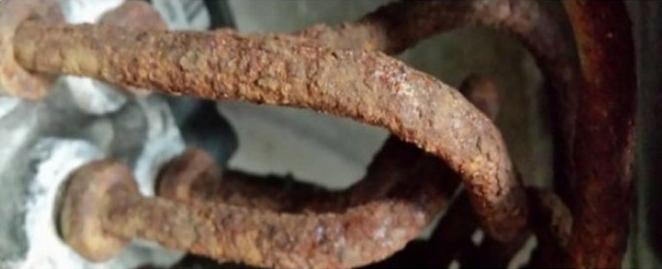
Home, Auto Repair Library, Auto Parts, Accessories, Tools, Manuals & Books, Car BLOG, Links, Index



A common cause of brake failure is rusty steel brake lines. Brake lines are made of double-wall furnace welded steel tubing. Steel is used for brake lines because it is strong and can withstand hundreds of pounds of hydraulic pressure when the brakes are applied. But steel is vulnerable to corrosion. To help protect the lines, a thin coating of terne (a lead/tin alloy) or a zinc-rich paint or epoxy is applied to the outside of the tubing. Over time, this coating can wear away or be chipped by road debris allowing rust to attack the tubing. A little surface rust won't hurt anything, but heavy flaking or bubbling rust is a sign that the brake lines are failing and need to be replaced. Eventually the rust will eat all the way through the tubing, causing the tubing to leak or blow out.
The older the vehicle and the more it has been exposed to road salt and heavy moisture, the greater the chance that rust is attacking and weakening the steel bgrake lines. On some vehicles (notably 1996 and newer GM pickup trucks), this type of failure has been reported in as little as five or six years. The problem is worse on vehicles that do not have a high quality anti-corrosion coating on their brake lines.
Loss of pressure in a brake line is a serious problem because it causes your brakes to fail. The brake systems in all vehicles since the late 1960s are split into two separate hydraulic circuits: front brakes and rear brakes, or diagonally with one front and the opposite rear brake sharing the same circuit. If one half of the system loses pressure because of fluid or pressure loss, you should still have two working brakes to help bring your vehicle to a halt. Even so, it can increase the stopping distance dramatically because you only have two brakes that are still functioning.
There's not much you can do to protect your brake lines from rusting, except maybe to move to a dry climate like Arizona. Undercoating and paint can be applied to the brake lines, but the lines are often hard to reach and it's difficult to apply an even coating on all sides of the tubing.
As your vehicle ages, you should inspect the brake lines, hoses, calipers and other hydraulic components in the brake system for leaks or excessive corrosion. If the steel brake lines are in poor condition, don't take a chance. Replace them BEFORE the rust through and start to leak or blow out.

Replacing brake lines requires a certain amount of skill because straight steel tubing must be carefully bent to fit the old lines they replace. Use a tubing bender so the tubing isn't crimped. Also, the ends of the tubing must be double flared or shaped to match the original ISO type fittings so the pipes will seal properly and not leak. This job might best be left to a professional technician. It's a good idea to replace ALL of the rusty steel brake lines on a high mileage vehicle at the same time. If one tube has failed, chances are the other tubers are in equally poor condition and may fail soon.
WARNING: Never use copper tubing, aluminum tubing or any other type of tubing to replace a brake line. Use only double-wall steel tubing that is approved for automotive brake line use.
The brake lines must all be bled after they have been installed to remove air from the lines. If the brake lines are not bled, air can make the brake feel soft and spongy, and may also result in a very low brake pedal. Follow the bleeding procedure for your vehicle. Using the wrong bleeding procedure can leave air in the lines.
 More Brake Articles:
More Brake Articles: Click Here to See More Carley Automotive Technical Articles
Click Here to See More Carley Automotive Technical Articles